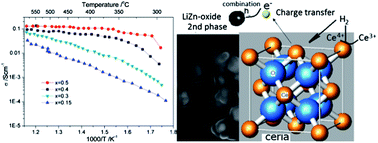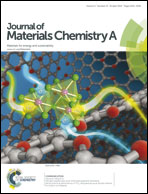Understanding the electrochemical mechanism of the core–shell ceria–LiZnO nanocomposite in a low temperature solid oxide fuel cell
Abstract
Ceria based solid solutions have been considered some of the best candidates to develop intermediate/low temperature solid oxide fuel cells (IT/LT-SOFCs, 600–800 °C). However, the barrier to commercialization has not been overcome even after numerous research activities due to its inherent electronic conduction in a reducing atmosphere and inadequate ionic conductivity at low temperatures. The present work reports a new type of all-oxide nanocomposite electrolyte material based on a semiconductor, Li-doped ZnO (LixZnO), and an ionic conductor, samarium doped ceria (SDC). This electrolyte exhibits superionic conductivity (>0.1 S cm−1 over 300 °C), net-electron free and excellent electrolytic performances (400–630 mW cm−2) between 480 and 550 °C. Particularly, defects related to interfacial conduction and the intrinsic and extrinsic properties of ions are analysed. An internal or interfacial redox process on two-phase particles is suggested as a powerful methodology to overcome the internal short-circuit problem of ceria-based single phase materials and to develop new advanced materials for energy related applications. The combination of the above promising features makes the SDC–LiZnO nanocomposite a promising electrolyte for LTSOFCs.


 Please wait while we load your content...
Please wait while we load your content...